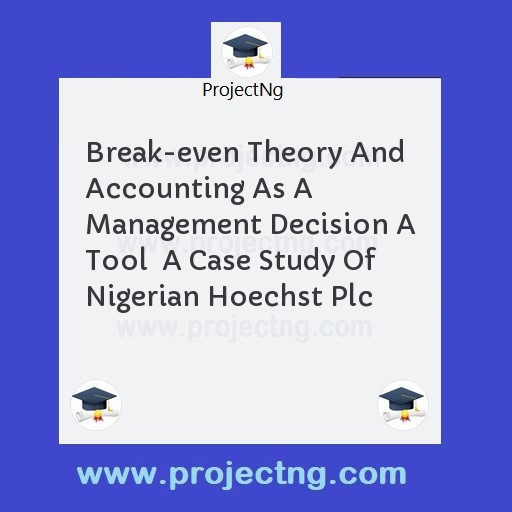Break-even Theory And Accounting As A Management Decision A Tool A Case Study Of Nigerian Hoechst Plc
Accounting Project Topics
Get the Complete Project Materials Now! »
BREAK-EVEN THEORY AND ACCOUNTING AS A MANAGEMENT DECISION A TOOL
A CASE STUDY OF NIGERIAN HOECHST PLC
PROPOSAL
This study is designed to analyze the Break-even theory and accounting as a decision tool in manufacturing company. The researcher will discuss the purpose and the importance of the techniques that are in operations and practiced by the company. It introduced the planning tool called the Break-Even chart that will make a major impact to assist management in profit planning, decision making and forecasting. It will also emphasizes on model of development relating to Break-Even analysis.
Data for this research work will be obtained through administering questionnaire through oral interview to the senior staffs of some manufacturing companies, after which critical analysis follows.
Regrettably however, the quest for information will be hindered by time and money factors. Lectures will be going on in the class, resources are scarce to travel wide and collect more information which would enable the researcher to write extensively on the topic.
In conclusion therefore, the researcher will suggest that Break-even techniques when applied, will help a business in profit planning, decision making and forecasting.
TABLE OF CONTENTS
PAGE
COVER PAGE I
TITLE PAGE II
APPROVAL PAGE III
DEDICATION IV
ACKNOWLEDGEMENT V
CHAPTER ONE-INTRODUCTION
1.1 BACKGROUND OF STUDY 1
1.2 HISTORICAL BACKGROUNDS OF NIGERIAN
HOECHST PLC 2
1.3 STATEMENT OF PROBLEMS 4
1.4 OBJECTIVE OF STUDY 5
1.5 SIGNIFICANCE OF STUDY 5
1.6 HYPOTHESIS AND RESEARCH QUESTIONS 6
1.7 SCOPE AND LIMITATION OF STUDY 7
1.8 DEFINITION OF TERMS 8
CHAPTER TWO – REVIEW OF LITERATURE
2.1 LITERATURE REVIEW 10
2.2 THEORETICAL FRAMEWORK OF STUDIES 18
2.3 MODEL DEVELOPMENT 24
2.4 TOOLS OF MANAGEMENT ACCOUNTING 48
2.5 CLASSIFICATION OF DECISION 49
CHAPTER THREE-RESEARCH DESIGN AND METHODOLOGY
3.1 INTRODUCTION
3.2 RESEARCH APPROACH 51
3.3 SAMPLING DESIGN AND POPULATION SIZE 52
3.4 SOURCE OF DATA 53
3.5 INTERVIEW QUESTIONS 54
3.6 METHOD OF DATA ANALYSIS 54
CHAPTER-PRESENTATION, ANALYSIS AND INTERPRETATION OF DATA
4.1 ANALYSIS OF DATA AND INTERPRETATION 58
4.2 HYPOTHESIS TESTING AND PROOFING 63
CHAPTER FIVE – SUMMARY OF FINDING. CONCLUSION AND RECOMMENDATION
5.1 SUMMARY OF FINDINGS 68
5.2 CONCLUSION
5.3 RECOMMENDATION
BIBLIOGRAPHY
APPENDIX I
APPENDIX II
CHAPTER ONE – INTRODUCTION
1.1 BACKGROUND OF STUDY
The success of a business is generally attributable in great measure of the ability of its management personal to cope with probable conditions of the future. Short range as well as long-term plans must be made accomplished through sound management evaluation. However, many aids have been controlling and co-ordinating the function of their business. One of the tool which encompasses vital and needed information in guiding companies profit path is the Break-Even theory. This is an extension of marginal costing; basically. It is concerned with the point at which revenue and costs intercedes, hence the term “Break – Even”.
Break-Even system is a simple and easily understandable method of picturing to the management the effect of changes in volume on profits. It predicts the effects of managerial actions today on future profits and company survival. Business people do not view costs outputs and profits may be affected by their actions. With the aid of Break-Even theory, they will be able to understand more and data revealed by the Break-Even analysis. This system involves the marshalling of the cost – volumer – profit data and other data to guide manager in its day-to-day decisions. Some of the data are best seen in a chart form for management to get a perspective view of the profit structure.
Moreover, at the beginning of the century a planning tool was developed by WALTER RAUTENSTRAUCH called the Break-Even chart. This development made a major contribution as a management aid in profit planning, forecasting and decision-making. The concept show the significance in a firm between it’s costs, volume and relationship between the costs, illustrate the relationship between the cost, that-the selling price is constant irrespective of the volume.
1.2 HISTORICAL BACKGROUND OF NIGERIA HOECHST PLC
On the 18th of December, 1963 the company was formed under the name “Hoechst Nigeria limited”. The company was registered as a private limited liability company with an authorized share capital of $10000 divided into 100 ordinary shares of $1 each on the 10th of January, 1964.
August 4th, 1971 the PVA plant at Ikeja commissioned for use. The major and company sold their 40% shareholding to E.O Ashamu and sons (holdings) Ltd. The same day the name of the company was change to “Nigerian Hoechst.
The authorized share capital was increased to N2 million by the
Be the First to Share On Social

Enjoying our content?
Don't miss out on new videos! Subscribe to our YouTube channel for more awesome content.
Subscribe Now!













